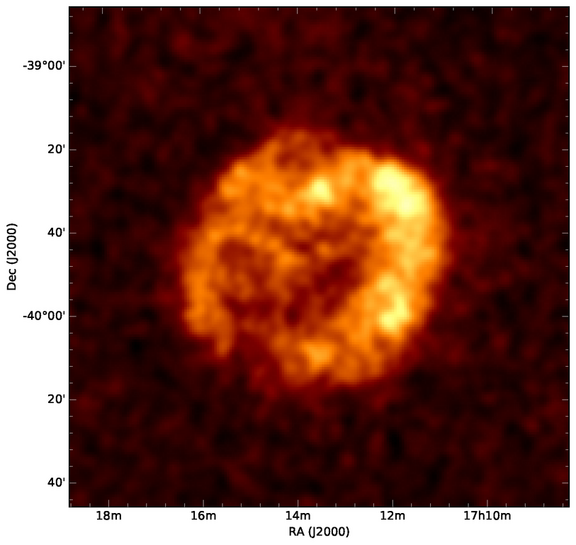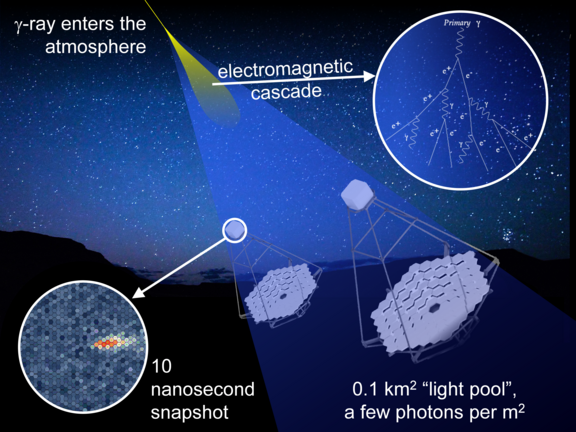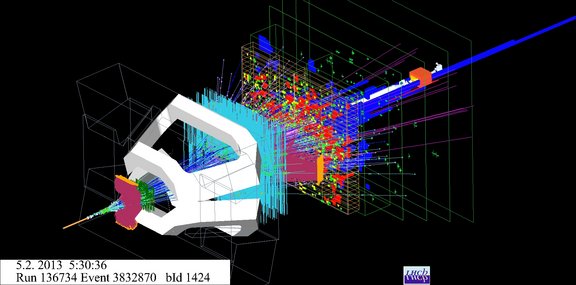Cosmic Accelerators – Astronomy at the Highest Energies
High-energy astrophysics at MPIK is characterized by a close cooperation between experimentalists and more theoretically oriented astrophysicists. They study non-thermal phenomena in the Universe using the High Energy Stereoscopic System H.E.S.S. in Namibia and the High Altitude Water Cherenkov Detector HAWC in Mexico to detect very-high-energy (VHE) gamma rays from the cosmos, in order to understand the acceleration of particles to extreme energies in cosmic sources and the role that these particles play in astrophysical systems.
Particles in the VHE range cannot be produced as thermal radiation, as is the electromagnetic radiation in most other wavelength regimes; only in the Big Bang were high enough temperatures reached for a very short time. VHE gamma radiation is produced when strongly accelerated charged particles interact with the interstellar gas or photon fields. In contrast to the charged particles, known as cosmic rays, the gamma rays travel in a straight line from the source to the observer, allowing the imaging of sources and the study of the astrophysical processes at work.
Charged particles can obtain very high energies in many astrophysical sources, for example in the giant shock waves generated in supernova explosions or in the plasma jets emerging from the immediate vicinity of the massive black holes at the centres of active galaxies. Considerable effort at the Institute is going into the modelling and theoretical description of processes within the different cosmic accelerators, as well as into VHE observations.
Recent highlights from H.E.S.S. include the detection of gamma-ray bursts and the first resolved emission from the jets of active galaxies in the gamma-ray band. In 2018 a whole issue of the journal Astronomy & Astrophysics was dedicated to H.E.S.S. observations within our own galaxy, where more than 80 VHE gamma-ray sources have been discovered. These objects include many supernova remnants and pulsar wind nebulae, several discovered in follow-up observations at other wavelengths, following the H.E.S.S. detections. The centre of the Milky Way is of particular interest and with H.E.S.S. VHE emission has been established from very close to the supermassive black hole at the heart of our galaxy, and also from gas clouds in the central region, bombarded by cosmic rays with up to petaelectronvolt (1 PeV = 1015 eV) energies and glowing in gamma rays.
HAWC observations complement those of H.E.S.S., providing sensitivity to larger-scale emission and up to higher energies. HAWC recently revealed very extended halos of high-energy electrons around two nearby pulsars and emission from the jets of the enigmatic Galactic micro-quasar known as SS 433.
Cherenkov Telescopes and Water Cherenkov Detectors
High-energy gamma rays from space – a trillion times more energetic than visible light – do not reach the Earth’s surface. Nevertheless, they can be detected at ground-level via the particle cascades (known as air showers) that they generate in the Earth’s atmosphere. One detection method makes use of the faint, bluish, and extremely short flashes of light (Cherenkov light) which the air showers produce. On dark nights these flashes can be detected using very large reflecting telescopes equipped with very fast and highly specialised cameras. To determine accurately the direction of the incoming gamma ray, the shower is observed stereoscopically by several of these telescopes.
H.E.S.S. consists of five telescopes, four of them are identically constructed, each with 107 m2 mirror area and deployed in a square of side length 120 m. A camera composed of light sensors is placed at the focus of each mirror. In the centre of the array, a fifth, huge telescope with 614 m2 mirror area equipped with a camera of novel technology, enhances the sensitivity of the system and extends observations to lower energies. H.E.S.S. was the first instrument that was able to produce true images of astrophysical gamma-ray sources.
Preparations are underway for a next generation observatory with dramatically improved performance. The Cherenkov Telescope Array (CTA) will consist of two arrays, in Chile and the Canary Island of La Palma, with around 100 telescopes of three different sizes. CTA will bring much better resolution, higher sensitivity, a much wider energy range, and a collection area of many square kilometres at the highest energies. The MPIK instrumentation effort is in developing state-of-the-art cameras for small and medium-sized telescopes.
At high-altitude sites, the shower particles can be observed directly – and around the clock – using water-filled detectors, where they also produce Cherenkov light. The main detector of the HAWC observatory consists of a dense array of 300 tanks at an altitude of 4100 m. The tanks are filled with high-purity water and equipped with light sensors. They are surrounded by a sparse array of 350 smaller “outrigger” tanks, which significantly improve the characterisation of particle showers hitting the boundary area of the main array. The MPIK is playing a major role in the development of a next-generation gamma-ray observatory with large field-of-view, placed in the southern hemisphere, the Southern Wide-field Gamma-ray Observatory (SWGO). SWGO will make use of the same detection principle as HAWC, but cover a larger area and record a wider range of gamma-ray energies.
The Early Universe – Elementary Particles at Highest Energies
In high-energy collisions between elementary particles, a fraction of the kinetic energy is transformed into short-lived particles normally not found in nature, but that existed in the extremely hot and dense state of the Universe immediately after the Big Bang. Such particle collisions allow one to study the fundamental interactions between the elementary constituents of our world and to learn about the physics at the beginning of the Universe.
A group at MPIK is a member of the LHCb collaboration, which operates one of the four large experiments at the CERN Large Hadron Collider (LHC). In proton-proton collisions, the experiment does precision measurements of the properties of the strong, electromagnetic and weak interactions, and probes in proton-nucleus collisions the effects of the nuclear environment. Nucleus-nucleus collisions, finally, give access to collective phenomena in extended systems consisting of free quarks and gluons, so-called quark-gluon plasmas.
These measurements shed light on the properties of the Universe when it was less than a nanosecond old. At the same time, they contribute to the understanding of the interactions of high-energy cosmic rays with the atmosphere, which is needed for the interpretation of the data collected by the Cherenkov detectors.


